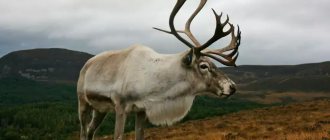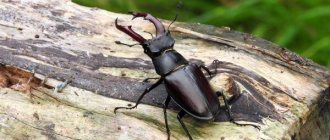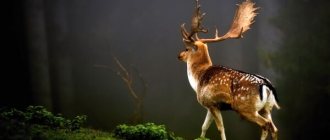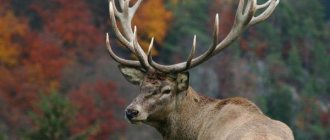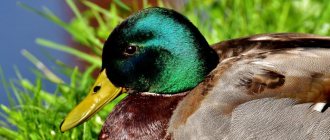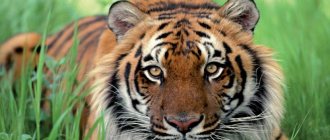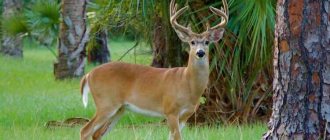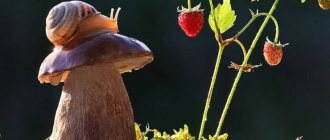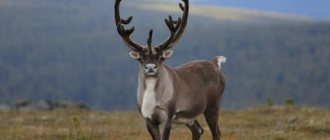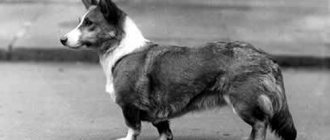The name of the animal deer comes from the Old Slavonic word “elen”. This is what our ancestors called this beautiful and graceful animal with luxurious branched horns. Ancient peoples, for example, Indian tribes, considered it sacred.
According to ancient Indian legends, an unexpected meeting with a deer in the forest promised happiness and good luck in the future. And the killing of this beautiful animal was considered a great crime and a bad omen for the American Indians. Among the ancient Celts, the deer was a symbol of the sun and fertility.
Features of deer
Each type of deer has its own specific size. However, they all have well-developed and strong leg muscles, which save them in difficult and dangerous situations. Fleeing from predators, animals reach speeds of more than 50 km/h.
Deer hair provides great warmth in the winter, but can be very thin in the summer months. The fur of animals is brown, gray, brown, red, red-brown, depending on the species. It can be found in either a single color or with spots or markings. And by looking at the teeth you can easily determine the age of the animal.
Enemies in nature
Under natural conditions, a dangerous enemy of deer is
wolf bears, from which deer often manage to escape with the help of their muscular legs. However, a pack of wolves, especially one acting in a coordinated manner, can easily drive down an old or sick deer. Also a dangerous enemy of deer is the human hunter, who kills this amazing animal for the sake of its antlers, which he then hangs as a hunting trophy somewhere near the fireplace.
Deer antlers - a weapon of defense
Male deer have wide, branched antlers (antlers). The exception is the water deer, which does not have antlers. Among the female representatives, only female reindeer have antlers. However, they are much smaller in size than males.
Note!
- Euthanasia of animals.
- Spitz. Features of the breed.
Car hammock for dogs. What it is?
Many reindeer shed their antlers every year. This period occurs in spring. New horns grow in place of old horns. With a good diet, deer antlers grow quickly. Inhabitants of southern latitudes may not shed their antlers for years.
The width of the horns of an adult male can be more than 120 cm. With them, animals protect themselves from enemies and participate in the fight for the female during the mating season. With the help of massive antlers, reindeer get their food by raking snow drifts in search of their favorite delicacy - moss.
The largest and most luxurious horns in animals are observed at the age of 5-12 years. In subsequent years they weaken and their scope decreases.
Subfamily Roe deer (Capreolinae)
Representatives of the Roe deer subfamily differ from True deer in the rudimentary metacarpal bones of the first and fifth fingers.
European roe deer
This animal inhabits forests, forest-steppes and bushes of Europe, Asia Minor, southern Siberia and the Far East, Mongolia, China, and Korea.
The dimensions are relatively small: body length no more than 123 cm, height at the withers 64-89 cm, body weight - 17-23 kg. The horns are vertical, branching.
European roe deer (Carreolus capreolus) with calf
Summer body color is red, the muzzle is gray, the chin is white, and the nasal surface is black. The winter background color is greyish-brown, with a white throat and tail.
Elk
Elk is an inhabitant of Siberia and the Far East, Northern Europe, Mongolia, northeastern China, Alaska, western Canada, northwestern USA; introduced to New Zealand. Inhabits coniferous and mixed lowland forests, forest-tundra. There are 6 known subspecies of moose.
Elk (Alces alces)
Elk is the largest representative of the deer family: body length can reach 300 cm, height - 230 cm and weigh up to 800 kg. The horns are large, flattened, with up to 20 branches. The withers are well defined, the upper lip is wide, and an “earring” hangs from the throat.
The color is blackish-brown above, brownish below. The lower part of the limbs is whitish. The exposed area of skin between the nostrils (nasal planum) is very small. You can read more about moose here.
Reindeer
Found in Northern Europe, Siberia, the Far East, Sakhalin, Alaska, Canada, Greenland and adjacent islands; within the entire natural range – including in the domesticated state. Habitats: tundra, woodland.
Reindeer (Rangifer tarandus)
The height of the reindeer at the withers is 94-127 cm, weight is 90-275 kg. Both males and females have horns, although in the latter their size is somewhat smaller. The horns are branched, the processes are flattened, especially the orbital ones in males. Males go without horns from November to April, females from May to June. The length of the horns of males is up to 147 cm, the number of processes is up to 44.
The color is brown in summer, gray in winter: the tail mirror and the lower part of the limbs are white, the neck is lighter, the cheeks and upper limbs are dark. Males develop a mane during the rut; the nasal planum is absent (the only case in the family).
Northern Pudu
Pudu is the smallest deer in the world. The southern pudú inhabits the low-mountain forests of Chile and Argentina; The northern pudú lives in Ecuador, Peru, and Colombia, where it has chosen the dense forests of the lower Andes belt.
The body height at the withers of the southern Pudu is 35-38 cm, the northern one is slightly larger - up to 45 cm; the weight of these deer does not exceed 10 kg. The horns of the northern Pudu are stiletto-shaped, its color is reddish-brown, while the head and limbs are almost black. The Southern Pudu is reddish, with lighter fur on the sides and legs.
Southern Pudu (Pudu pudu)
Habitat and lifestyle
The habitat of deer is very widespread. At the same time, they adapt well to life both on wide plains and in rocky mountains and foothills, tundra and swampy areas.
Deer love to settle in places with high humidity, near bodies of water. These animals lead a nomadic life, forming herds whose numbers vary from 10 to 30 individuals.
In summer they live in forests. Here there are all the necessary conditions to support life: a variety of trees and fragrant herbs that serve as excellent food. In winter, on the contrary, animals wander into impenetrable thickets, which are less covered with snow. Here it is easier for them to find food.
Note!
- Removal and cremation of animals
Cynologists - who are they?
Car soundproofing. What is she like?
Fur, not wool
Unlike other animals that are warmed by fur in frosty or cold weather, the deer epidermis is covered with continuous fur. It is thin and short in the warm season and elongated and thick in winter.
The color of deer fur is different; it not only protects the body from frost or overheating, but also functions as mimicry - adaptation to the color of their external environment: gray, brown, white, and so on.
Diet
Forest deer are herbivores. Their diet includes green grass, leaves, young shoots of trees, tree bark and juicy fruits: ripe apples, pears and wild berries, which animals love very much.
Deer living in the north eat pine needles, lichens and acorns, as well as moss, which they get by tearing up the snow with their strong branched antlers. To compensate for the lack of minerals in the body, they drink healing water from mineral springs.
Mating season
Deer gather in small herds, which consist of several adult females, cubs and a strong male during the mating period. In the fall, many deer begin their rut, which ends at the beginning of winter. Throughout the mating season, the roar of a deer can be heard at an impressive distance.
At this time, males often sort things out among themselves. The main weapon of struggle is the horns. With them the deer tries to knock the opponent to the ground. Sexual maturity in males occurs at 2-3 years. In females even earlier - by 1.5 years.
Reproduction
Pregnancy in females lasts 6-9 months, depending on the species. As a rule, only one cub is born, rarely two. Almost immediately after birth, the baby stands on its feet. And a few weeks later he nibbles the grass and young shoots of the plants. However, he drinks his mother's milk for the entire first year of his life.
From birth, small fawns have a beautiful spotted color. It helps camouflage from predators. Touching photos of baby deer, published in specialized nature magazines and on the Internet, provide an opportunity to get a closer look at the life of these amazing animals.
A year later, small tubercles can be seen on the males’ heads - the first small horns. In subsequent years, branches appear on the horns, and each new horn becomes stronger and more massive.
Classification
Different researchers identify different numbers of species of this animal. Thus, on the territory of Eurasia you can find such species as:
- european reindeer
- Novaya Zemlya reindeer
- Siberian reindeer
- Siberian forest reindeer
- European forest
- Okhotsk
- Barguzinsky
- reindeer of the Spitsbergen archipelago.
However, zoologists recognize that not all forms can be identified as a separate species, so often the classification appears shorter due to grouping into larger groups . For example, the catalog of mammals published in the USSR contained only six species.
On the territory of modern Russia, three subspecies of reindeer are distinguished:
- European,
- Siberian,
- Okhotsk
In addition, scientists know of two subspecies that have disappeared from the planet:
- East Greenladian
- Queen Charlotte Island reindeer.
Even if we classify deer by habitat, the authors can distinguish two or three species:
- tundra,
- taiga,
- mountain
The latter type is not highlighted by all researchers.


